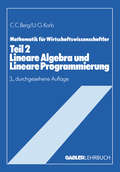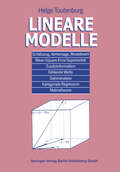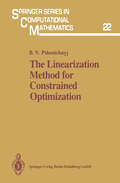- Table View
- List View
Lineare Algebra und Lineare Programmierung: Teil II Lehrstoffkurzfassung und Aufgabensammlung mit Lösungen
by Claus C. Berg Ulf-Günther KorbLineare Entscheidungsmodelle (Enzyklopädie der Rechts- und Staatswissenschaft)
by Wilhelm Kromphardt Rudolf Henn Karl FörstnerLineare Entscheidungsmodelle zur Organisations- und Personalplanung (Physica-Schriften zur Betriebswirtschaft #44)
by Thomas S. SpenglerLineare Erfolgsbeteiligung: Grundprobleme der Agency-Theorie im Licht des LEN-Modells (Physica-Schriften zur Betriebswirtschaft #66)
by Louis John VelthuisDas Buch beschäftigt sich mit der linearen Erfolgsbeteiligung als Anreizinstrument. Der nachgeordnete Entscheidungsträger soll motiviert werden, sich anzustrengen, gute Entscheidungen zu treffen und seine Aktivitäten effizient auf Aufgaben zu verteilen. Als Analyserahmen dient das LEN-Modell, in dem von einer linearen Entlohnungsfunktion, exponentiellen Nutzenfunktionen und normalverteilten Erfolgen ausgegangen wird. Hierdurch erhält das Modell eine einfache Struktur, die eine Herleitung von expliziten, anschaulichen Ergebnissen erlaubt. Im Mittelpunkt der Betrachtung steht zum einen die theoretische Rechtfertigung einer linearen Erfolgsbeteiligung und zum anderen die Analyse der Konsequenzen einer Erfolgsbeteiligung in unterschiedlichen Entscheidungssituationen bei Risiko.
Lineare Modelle: Theorie und Anwendungen
by Helge ToutenburgDieses Buch gibt einen vollständigen Überblick über Lineare Modelle und verwandte Gebiete, z.B. die Matrixtheorie. Das Buch umfasst Theorie und Anwendungen. Zahlreiche Beispiele sowie Datensätze, Tests und Grafiken (Tests auf Strukturbrüche/Parameterkonstanz) auf einer Website dienen der Anwendungsorientierung. Ein eigenes, relativ umfangreiches Kapitel zur Matrixtheorie stellt die notwendigen methodischen Hilfsmittel für die Beweise der Sätze im Text bereit und vermittelt eine Auswahl klassischer und moderner algebraischer Resultate. Das Buch ist vor allem als begleitendes Lehrmaterial für Studenten, für die Forschung auf dem Gebiet der Linearen Modelle sowie für Dozenten und Studenten höherer Semester der Wirtschaftswissenschaften angelegt.
Lineare Modelle
by Helge ToutenburgNeben dem Standard der Linearen Modelle behandelt das Lehrbuch eine Reihe neuer Methoden, Kriterien und Resultate. Auf der Basis neuerer Ergebnisse der Matrixtheorie werden Gütevergleiche zwischen verzerrten Schätzungen möglich, die den Einsatzbereich schwacher Zusatzinformation und von Imputationsverfahren bei unvollständiger Designmatrix erweitern. Die Einarbeitung dieser Resultate einerseits und die Berücksichtigung von Modellwahlverfahren (mit SPSS), von Imputationsmethoden für fehlende Daten, von Sensitivitätsbetrachtungen und der kategorialen Regression andererseits bedeuten eine wesentliche Erweiterung des Methodenangebots vergleichbarer Bücher zu Linearen Modellen. Ein eigenes, relativ umfangreiches Kapitel zur Matrixtheorie stellt die notwendigen methodischen Hilfsmittel für die Beweise der Sätze im Text bereit und vermittelt eine Auswahl klassischer und moderner algebraischer Resultate. Durch die Einarbeitung von Beispielen wird die Anwendung der Schätz- und Modellwahlverfahren demonstriert.
Lineare Optimierung: Modell, Lösung, Anwendung (Studienbücher Wirtschaftsmathematik)
by Thomas Unger Stephan DempeAnhand vieler Praxisbeispiele aus den Wirtschaftswissenschaften bietet dieses Buch einen praktischen Einstieg in die Lineare Optimierung. Dabei werden dem Leser insbesondere die zugrunde liegenden Ideen nahe vermittelt. Zu den zahlreichen Aufgaben werden ausführliche Musterlösungen angeboten. Darüber hinaus helfen Ihnen die Beispielklausuren bei der gezielten Vorbereitung auf Klausuren.
Lineare Optimierung im Transportwesen
by Vladimír KadlecDie En Lwiddung der sozialistischen Produktion wird vor allem durch die Steigerung der Arbeilsproduktivitiit und die Erhöhung der Wirtschaftlichkeit bestimmt. Sie erfordert eine ständige Verbesserung und Vervollkommnung der Leitttngsmetlwden. Ükonomische Entscheidungen und technisch-wirtschaftliche Analysen können sich künftig bei den immer komplizierter werdenden Beziehungen zwischen den Produzenten und den Verbrauchern beziehungsweise den Lieferbetrieben und den Abnehmern nicht mehr lediglich auf die bisher gebräuchlichen, relativ wenig genauen Methoden stützen. Man kann nicht mehr allein von den Erfah mngen ausgehen oder sich nur auf die Intuition und die berufliche Routine der ökonomischen Mitarbeiter verlassen. Die Forderungen nach Verbesserung der bisherigen Methoden und Mittel der Leitung zielen in den industriell entwickelten Liindern relativ stark auf die 1 Ausnutzung der sogenannten Verfahrensforschung. Die V erfahrensforsehung ist keine einheitliche Methode oder Technik einer wirksamen Leitung. Grob kann gesagt werden, daß es sich im Gegenteil um einen Komplex von Methoden handelt, die auf der Grundlage des Studiums bestimmter Tätigl
Lineare Optimierung unter Unsicherheit: Eine Einführung
by Frank HerrmannGegenstand dieses Buches sind die in der Literatur und auch in der aktuellen Forschung verwendeten Ansätze der linearen Optimierung unter Unsicherheit. Im Mittelpunkt stehen Kompensationsprobleme und ihre Alternativen wie „Chance Constrained“-Probleme oder Sensitivitätsanalysen bzw. ihre Erweiterung, die parametrische Optimierung. Diese Ansätze werden mathematisch präzise beschrieben und ihre charakteristischen Eigenschaften werden anhand von leicht nachrechenbaren Fallstudien erläutert. Da durch Kompensationsprobleme häufig die besten Resultate erzielt werden, werden mit diesen Abstraktionen von konkreten Problemen in Unternehmen gelöst.Das Buch wendet sich an Doktoranden und Studierende mit ausgeprägtem Interesse an der optimalen Lösung von Problemen, insbesondere aus dem Bereich der Produktionsplanung, sowie generell an Wissenschaftler und Experten in Unternehmen, die eine Einführung in die lineare Optimierung unter Unsicherheit suchen.
Lineare Planungsrechnung und Netzplantechnik (Operations Research Proceedings Ser. #1nbsp;nbsp;)
by Bodo RunzheimerLineare Programmierung und Erweiterungen (Ökonometrie und Unternehmensforschung Econometrics and Operations Research #2)
by G. B. DantzigLineare und nichtlineare Anreizsysteme: Ein Vergleich möglicher Konsequenzen (Betriebswirtschaftliche Studien)
by Helmut Laux Heike Schenk-MathesEs werden Modelle zur Ermittlung eines optimalen erfolgsorientierten Belohnungssystems analysiert. Zunächst werden lineare Belohnungsfunktionen betrachtet, bei denen der Entscheidungsträger auch am Verlust beteiligt wird. Danach werden die möglichen Folgen eines Ausschlusses der Verlustbeteiligung herausgearbeitet und außerdem der Fall betrachtet, daß der Entscheidungsträger neben einem Fixum eine zusätzliche Belohnung erhält, sofern ein vorgegebener Sollerfolg erreicht wird. Die betreffenden Belohnungsfunktionen sind zwar von großer praktischer Bedeutung; sie sind jedoch grundsätzlich nicht anreizkompatibel. Es wird gezeigt, welche Gestalt anreizkompatible Belohnungsfunktionen aufweisen und wie eine optimale anreizkompatible Belohnungsfunktion im Prinzip ermittelt werden kann. Im Gegensatz zu den üblichen Annahmen der Agency-Theorie wird berücksichtigt, daß die Wahrscheinlichkeitsverteilung über den Erfolg nicht nur vom Aktivitätsniveau des Entscheidungsträgers, sondern auch von den dabei realisierten Objektentscheidungen abhängt. Die bestehenden Zusammenhänge werden mit Hilfe zahlreicher Graphiken veranschaulicht.
Linearitäten in Anreizverträgen bei groben Informationsstrukturen (Beiträge zur betriebswirtschaftlichen Forschung #77)
by Wolfgang BreuerEs ist empirisch erwiesen, daß als Gegenleistung für die Erbringung von Diensten häufig Vergütungen vereinbart werden, die linear oder abschnittsweise linear in einer Erfolgsgröße sind. So lassen sich die Zahlungsstrukturen von Beteiligungs- und Forderungstiteln als Ergebnis einer - abschnittsweise - linearen Vergütungsregelung für den geschäftsführenden Gesellschafter einer Unternehmung interpretieren.
The Linearization Method for Constrained Optimization (Springer Series in Computational Mathematics #22)
by Boris N. PshenichnyjTechniques of optimization are applied in many problems in economics, automatic control, engineering, etc. and a wealth of literature is devoted to this subject. The first computer applications involved linear programming problems with simp- le structure and comparatively uncomplicated nonlinear pro- blems: These could be solved readily with the computational power of existing machines, more than 20 years ago. Problems of increasing size and nonlinear complexity made it necessa- ry to develop a complete new arsenal of methods for obtai- ning numerical results in a reasonable time. The lineariza- tion method is one of the fruits of this research of the last 20 years. It is closely related to Newton's method for solving systems of linear equations, to penalty function me- thods and to methods of nondifferentiable optimization. It requires the efficient solution of quadratic programming problems and this leads to a connection with conjugate gra- dient methods and variable metrics. This book, written by one of the leading specialists of optimization theory, sets out to provide - for a wide readership including engineers, economists and optimization specialists, from graduate student level on - a brief yet quite complete exposition of this most effective method of solution of optimization problems.
A Liner Shipping Network Design: Routing and Scheduling Considering Environmental Influences (Produktion und Logistik)
by Volker WindeckThe liner shipping network design delivers schedules and routes for ships that continuously visit harbours on a closed round trip. Examples of such ships are container ships that in many cases maintain a weekly harbour visiting frequency. Volker Windeck elaborates a liner shipping network design approach which is not only considering the harbours to be visited, cargo to be transported and number of ships available, but also considers environmental influences. Additionally the revenue contribution of alternative propulsion system can also be analysed. Extensive numerical tests indicate that significant savings are obtained when using this liner shipping network design approach.
Linguistic Decision Making: Theory and Methods
by Zeshui XuThis book provides a systematic introduction to linguistic aggregation operators, linguistic preference relations, and various models and approaches to multi-attribute decision making with linguistic information. Offers practical examples, tables and figures.
Linguistic Geometry: From Search to Construction (Operations Research/Computer Science Interfaces Series #13)
by Boris StilmanLinguistic Geometry: From Search to Construction is the first book of its kind. Linguistic Geometry (LG) is an approach to the construction of mathematical models for large-scale multi-agent systems. A number of such systems, including air/space combat, robotic manufacturing, software re-engineering and Internet cyberwar, can be modeled as abstract board games. These are games with moves that can be represented by the movement of abstract pieces over locations on an abstract board. The purpose of LG is to provide strategies to guide the games' participants to their goals. Traditionally, discovering such strategies required searches in giant game trees. These searches are often beyond the capacity of modern and even conceivable future computers. LG dramatically reduces the size of the search trees, making the problems computationally tractable. LG provides a formalization and abstraction of search heuristics used by advanced experts including chess grandmasters. Essentially, these heuristics replace search with the construction of strategies. To formalize the heuristics, LG employs the theory of formal languages (i.e. formal linguistics), as well as certain geometric structures over an abstract board. The new formal strategies solve problems from different domains far beyond the areas envisioned by the experts. For a number of these domains, Linguistic Geometry yields optimal solutions.
Linguistic Pragmatics of Intercultural Professional and Business Communication
by Elena N. Malyuga Svetlana N. OrlovaThis monograph presents the result of the authors’ scientific research on the development of cognitive discursive approach to issues of intercultural professional and business communication (IPBC) and the study of the language of professional communication, the links binding the language with non-linguistic and extralinguistic realia in the framework of cognitive linguistics, as well as oral and written communication in intercultural professional business discourse. The authors proceed from the assumption that IPBC can only reach maximum efficiency provided that its participants assimilate its inherent norms and rules and are able to skillfully implement these norms and rules to verbalise their cognitive activity in the sphere of professional business interaction. Topics covered include: analysis of the theory of business communication, of codified and uncodified vocabulary, theory of euphemy, and euphemisms used in intercultural professional and business communication.
Link: How Decision Intelligence Connects Data, Actions, and Outcomes for a Better World
by Lorien PrattWhy aren't the most powerful new technologies being used to solve the world's most important problems: hunger, poverty, conflict, inequality, employment, disease? What's missing? From a pioneer in Artificial Intelligence and Machine Learning comes a thought-provoking book that answers these questions. In Link: How Decision Intelligence Connects Data, Actions, and Outcomes for a Better World, Dr. Lorien Pratt explores the solution that is emerging worldwide to take Artificial Intelligence to the next level: Decision Intelligence. Decision Intelligence (DI) goes beyond AI as well, connecting human decision makers in multiple areas like economics, optimization, big data, analytics, psychology, simulation, game theory, and more. Yet despite the sophistication of these approaches, Link shows how they can be used by you and me: connecting us in a way that supercharges our ability to meet the interconnected challenges of our age. Pratt tells the stories of decision intelligence pioneers worldwide, along with examples of their work in areas that include government budgeting, space exploration, emerging democracy conflict resolution, banking, leadership, and much more. Link delivers practical examples of how DI connects people to computers and to each other to help us solve complex interconnected problems. Link explores a variety of scenarios that show readers how to design solutions that change the way problems are considered, data is analyzed, and technologies work together with people. Technology and academics has accelerated beyond our ability to understand or effectively control them. Link brings technology down to earth and connects it to our more natural ways of thinking. It offers a roadmap to the future, empowering us all to make practical steps and take the best actions to solve the hardest problems.
Link: How Decision Intelligence Connects Data, Actions, and Outcomes for a Better World
by Lorien PrattWhy aren't the most powerful new technologies being used to solve the world's most important problems: hunger, poverty, conflict, inequality, employment, disease? What's missing? From a pioneer in Artificial Intelligence and Machine Learning comes a thought-provoking book that answers these questions. In Link: How Decision Intelligence Connects Data, Actions, and Outcomes for a Better World, Dr. Lorien Pratt explores the solution that is emerging worldwide to take Artificial Intelligence to the next level: Decision Intelligence. Decision Intelligence (DI) goes beyond AI as well, connecting human decision makers in multiple areas like economics, optimization, big data, analytics, psychology, simulation, game theory, and more. Yet despite the sophistication of these approaches, Link shows how they can be used by you and me: connecting us in a way that supercharges our ability to meet the interconnected challenges of our age. Pratt tells the stories of decision intelligence pioneers worldwide, along with examples of their work in areas that include government budgeting, space exploration, emerging democracy conflict resolution, banking, leadership, and much more. Link delivers practical examples of how DI connects people to computers and to each other to help us solve complex interconnected problems. Link explores a variety of scenarios that show readers how to design solutions that change the way problems are considered, data is analyzed, and technologies work together with people. Technology and academics has accelerated beyond our ability to understand or effectively control them. Link brings technology down to earth and connects it to our more natural ways of thinking. It offers a roadmap to the future, empowering us all to make practical steps and take the best actions to solve the hardest problems.
Link Technology to Your Long-Term Business Goals: How to Use Technology to Mobilize Your People, Strategy and Operations
by PrazLink the use of technology with long-term business goals to optimize the core elements in your organization: people, strategy, and operations. This book will show you how effective planning of processes and execution of strategies with the help of technology can bring about an organization-wide increase in productivity and performance.Business environments have grown increasingly competitive. Before an organization realizes what has happened, it can lose or gain market share. Being agile is the key to success. This book covers the processes that can help your enterprise be agile and follow best practices when executing your business strategy.You'll review case studies from real-world experiences that dive deep into the problems a business encounters and the ways to solve those challenges. They deal with the different ways in which your organization can achieve dramatic performance improvements by changing your company’s processes. The book also explains how objectives and key results can be used to align business teams for increased productivity. With Use Tech to Mobilize Your People, Strategy, and Operations you'll learn how the intensity of core processes can ensure that growth does not wane in your organization. What You'll Learn Know the role of three core elements in organizations: people, strategy, operationsUnderstand how technology can enhance these three core elementsBe aware of the importance of scale and security in the information eraEliminate distractions and uncertainty in core processesWho This Book Is ForPeople with experience building businesses (founders, CEOs, COOs, CTOs, project managers, product managers, operation heads, sales heads, finance heads, strategy heads, technology leaders) who are looking for technology solutions to business problems
Linkage Inc's Best Practices in Leadership Development Handbook: Case Studies, Instruments, Training (J-B US non-Franchise Leadership #319)
by Linkage Inc.Leadership development is a planned effort that enhances the learner's capacity to lead people. Building on the success of the first edition, Linkage conducted a study of over 300 top organizations and their needs in organizational change and leadership development that identifies approaches to leadership development that have proven to be successful. The work offers practical "how-to" instructions developing leaders and engaging in leadership development. It provides current in-depth models, assessments, tools, and other instruments that can be used for immediate application within a variety of organizations.























